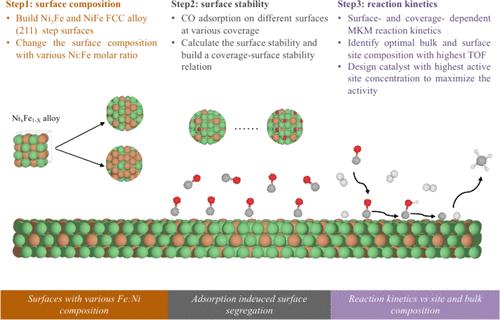当前位置:
X-MOL 学术
›
ACS Catal.
›
论文详情
Our official English website, www.x-mol.net, welcomes your feedback! (Note: you will need to create a separate account there.)
CO Methanation over Ni–Fe Alloy Catalysts: An Inverse Design Problem
ACS Catalysis ( IF 11.3 ) Pub Date : 2024-07-22 , DOI: 10.1021/acscatal.4c02449 Wenqiang Yang 1, 2 , Zhenbin Wang 3 , Jens K. Nørskov 1
ACS Catalysis ( IF 11.3 ) Pub Date : 2024-07-22 , DOI: 10.1021/acscatal.4c02449 Wenqiang Yang 1, 2 , Zhenbin Wang 3 , Jens K. Nørskov 1
Affiliation

|
We propose an approach to solve the inverse design problem in heterogeneous catalysis in which the goal is to find a material composition and structure that will maximize the active surface site under reaction conditions with knowledge of the active site motif being given. Taking CO methanation over Ni–Fe bimetallic alloys as our basis catalyst systems, we aim to identify a Ni–Fe bulk/surface composition that can provide the highest activity under reaction conditions. First, the stability of various (211) surfaces with different surface and bulk compositions is studied, especially if the CO adsorption could induce surface segregation has been well studied since CO is found to dominantly cover the surface during CO methanation. Due to a similar binding strength of CO over Ni and Fe, we did not observe surface segregation induced by CO adsorption. Reaction kinetics on the corresponding stable surfaces are obtained through coverage- and surface-consistent MKM. The 4-Fe Ni3Fe(211) surface site, which corresponds to 4 Fe atoms on the surface, is the most active site among all the stable surfaces. This high activity is attributed to the presence of a pure Ni step site and an adjacent Fe site, which are particularly active for CO activation (CO + H → COH) and dissociation (COH → C + OH), respectively. Additional calculations on reaction barriers for these two rate-controlling steps on similar Ni3Fe(211) surfaces confirmed that the 1-Fe Ni3Fe(211) surface, despite being less stable, shows lower reaction barriers, suggesting the potential for further activity enhancement. Consequently, we propose that optimizing Ni1–xFex catalysts for CO methanation may involve synthesizing Ni3Fe catalysts with a focus on stabilizing the active site motif identified under the reaction conditions. The proposed approach offers a strategic pathway for researchers aiming to solve the inverse design problem for catalysts in other reaction systems.
中文翻译:

Ni-Fe 合金催化剂上的 CO 甲烷化:逆设计问题
我们提出了一种解决多相催化中逆向设计问题的方法,其目标是找到一种材料成分和结构,在已知活性位点基序的情况下,在反应条件下最大化活性表面位点。以 Ni-Fe 双金属合金上的 CO 甲烷化作为我们的基础催化剂系统,我们的目标是确定一种 Ni-Fe 本体/表面组合物,可以在反应条件下提供最高的活性。首先,研究了具有不同表面和本体组成的各种(211)表面的稳定性,特别是如果 CO 吸附可能引起表面偏析,则已得到充分研究,因为发现 CO 甲烷化过程中 CO 主要覆盖表面。由于 CO 与 Ni 和 Fe 的结合强度相似,我们没有观察到 CO 吸附引起的表面偏析。通过覆盖率和表面一致的 MKM 获得相应稳定表面上的反应动力学。 4-Fe Ni 3 Fe(211) 表面位点对应于表面上的 4 个 Fe 原子,是所有稳定表面中最活跃的位点。这种高活性归因于纯 Ni 台阶位点和相邻 Fe 位点的存在,它们分别对 CO 活化 (CO + H → COH) 和解离 (COH → C + OH) 特别活跃。对类似 Ni 3 Fe(211) 表面上这两个速率控制步骤的反应势垒的额外计算证实,1-Fe Ni 3 Fe(211) 表面尽管较小稳定,显示出较低的反应势垒,表明进一步增强活性的潜力。 因此,我们建议优化用于 CO 甲烷化的 Ni 1–x Fe x 催化剂可能涉及合成 Ni 3 Fe 催化剂,重点是稳定下确定的活性位点基序。反应条件。所提出的方法为旨在解决其他反应系统中催化剂的逆设计问题的研究人员提供了一条战略途径。
更新日期:2024-07-22
中文翻译:

Ni-Fe 合金催化剂上的 CO 甲烷化:逆设计问题
我们提出了一种解决多相催化中逆向设计问题的方法,其目标是找到一种材料成分和结构,在已知活性位点基序的情况下,在反应条件下最大化活性表面位点。以 Ni-Fe 双金属合金上的 CO 甲烷化作为我们的基础催化剂系统,我们的目标是确定一种 Ni-Fe 本体/表面组合物,可以在反应条件下提供最高的活性。首先,研究了具有不同表面和本体组成的各种(211)表面的稳定性,特别是如果 CO 吸附可能引起表面偏析,则已得到充分研究,因为发现 CO 甲烷化过程中 CO 主要覆盖表面。由于 CO 与 Ni 和 Fe 的结合强度相似,我们没有观察到 CO 吸附引起的表面偏析。通过覆盖率和表面一致的 MKM 获得相应稳定表面上的反应动力学。 4-Fe Ni 3 Fe(211) 表面位点对应于表面上的 4 个 Fe 原子,是所有稳定表面中最活跃的位点。这种高活性归因于纯 Ni 台阶位点和相邻 Fe 位点的存在,它们分别对 CO 活化 (CO + H → COH) 和解离 (COH → C + OH) 特别活跃。对类似 Ni 3 Fe(211) 表面上这两个速率控制步骤的反应势垒的额外计算证实,1-Fe Ni 3 Fe(211) 表面尽管较小稳定,显示出较低的反应势垒,表明进一步增强活性的潜力。 因此,我们建议优化用于 CO 甲烷化的 Ni 1–x Fe x 催化剂可能涉及合成 Ni 3 Fe 催化剂,重点是稳定下确定的活性位点基序。反应条件。所提出的方法为旨在解决其他反应系统中催化剂的逆设计问题的研究人员提供了一条战略途径。












































 京公网安备 11010802027423号
京公网安备 11010802027423号